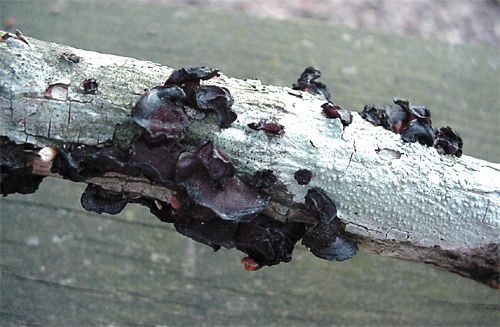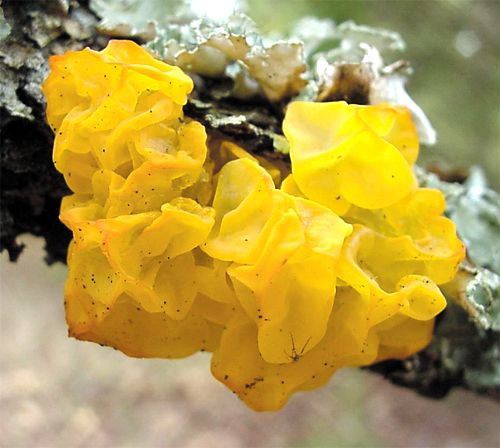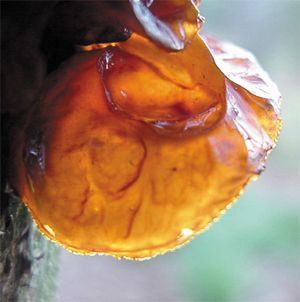|
|
|||
|
THIS WEEK at HILTON POND (Back to Preceding Week; on to Next Week) |
|
TREE-EAR & During wet weather in winter and early spring, dead limbs frequently fall from hardwood trees at Hilton Pond Center. Some branches reveal an unusual attribute--translucent fleshy structures reminiscent of the external ear flaps of a mammal. Rather than being auditory devices for the trees, however, these growths are a fungus that's appropriately called "Tree-Ear." Tree-Ear, Auricularia auricula, is common across North America, especially in the eastern United States. In dry periods, it is a thin, brownish-black, bark-hugging growth easily overlooked among the gray-green Crustose Lichens that often occur with it (below).  Once winter rains arrive, however, Tree-Ear absorbs water, becomes saturated, and takes on a more obvious ear-like configuration that makes its common name understandable (see photo below). 
All text & photos © Hilton Pond Center Tree-Ear is one of the Jelly Fungi, a diverse group distantly related to mushrooms and toadstools. Although fungal classification is under seemingly constant debate by taxonomists, some experts believe the "Jelly Fungi" includes just two orders: the Auriculariales--meaning "ear-shaped"--of which Tree-Ear is a member, and the Tremellales ("trembling" or "jellylike"). Both groups are characterized by fleshy reproductive structures that give rise to microscopic white or transparent spores that are sausage-shaped. (For the record, some mycologists also consider a third order, the Dacrymycetales, to be one of the so-called Jelly Fungi.) Hilton Pond Center is host to at least two kinds of Jelly Fungus: Tree-Ear and a more colorful yellow species called Witch's Butter, Tremella mesenterica. As its technical name suggests, Witch's Butter is in the Tremellales. This seasonal fungus also withers when there is little moisture, and then "blooms" with winter or spring rains (below). Jelly Fungi are seldom seen in summer in the Carolina Piedmont, perhaps because the weather is too hot and dry.
Surprisingly, the Jelly Fungi are edible; one recipe calls for Tree-Ear to be soaked, sliced, and added to casseroles to provide "snappy" texture. A related species in China is used regularly in soup, salads, and stir-fried dishes. The Chinese also believe Jelly Fungi improve breathing and circulation--an interesting assertion since chemicals found in some members of this group have been shown to inhibit blood clotting. It's reported that Witch's Butter is can be eaten, but that it has very little flavor.
The bottom line is that Tree-Ear causes no harm, except--as our precise measurements with an electronic balance have determined--when it absorbs up to 63 times its dry weight in rainwater. As this occurs, the dead branch that bears the fungus can become so heavy it strips from the tree and crashes earthward toward the cranium of an unsuspecting passerby--about the only reason we would consider wearing a hard hat while walking the fungal-laden woods at Hilton Pond Center. Comments or questions about this week's installment? NOTE: Be sure to scroll down for an account of all birds banded or recaptured during the week, as well as some other interesting nature notes. "This Week at Hilton Pond" is written & photographed You may wish to consult our Index of all nature topics covered since February 2000. You can also use the on-line Search Engine at the bottom of this page. For a free, non-fattening, on-line subscription to "This Week at Hilton Pond," just send us an E-mail with SUBSCRIBE in the Subject line. Please be sure to configure your spam filter to accept E-mails from hiltonpond.org. |


 Although some fungi are parasitic and can kill trees, such is not the case for Tree-Ear (right); it is apparently a saprophyte that lives only on dead wood. Conversely, Witch's Butter is indeed a parasite, not on the tree itself but on other wood-decaying fungi--a great example of a complex relationship among seemingly simple organisms!
Although some fungi are parasitic and can kill trees, such is not the case for Tree-Ear (right); it is apparently a saprophyte that lives only on dead wood. Conversely, Witch's Butter is indeed a parasite, not on the tree itself but on other wood-decaying fungi--a great example of a complex relationship among seemingly simple organisms!



